*Update: please see the Harewood House category for other posts about this project.*
We’ve had a very busy couple of weeks delivering two of our workshops and finishing off our new displays at Harewood as part of our collaborative project. The first workshop, on Thursday 11 August, was for students from IntoUniversity, a national charity which provides local learning centres where young people are inspired to achieve. In particular they work with children from disadvantaged postcode districts who are statistically less likely to go to university or enter the professions than those in more advantaged areas, providing academic support, mentoring, and informal educational opportunities.
In our case the workshop we ran fitted in nicely to a programme of activities the local Leeds centres were running over the summer holidays. Earlier that week the students had taken part in two other drama-based workshops, so they were familiar with performing with one another, and had also been learning about artificial intelligence and the way AI technologies might change our lives in the future. We thus framed our activities looking at the history of electricity as a way to see how people responded in the past to what was then a brand new technology which was beginning to become widespread in people’s homes, and looking at how people responded differently to this.
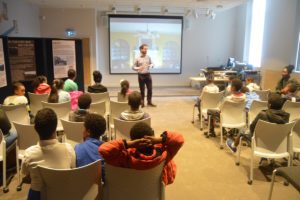
The workshop was split into three sections, beginning with a short piece of drama from our three performers based on new research in the archives at Harewood House and in the West Yorkshire Archives. Set in the 1930s, a time when many electrical systems in the house were being modernised and extended, the performance introduced the audience to members of staff at Harewood and to a visiting electrical engineer who was looking at the electrical systems, in particular the electrical call bells which needed to be improved.
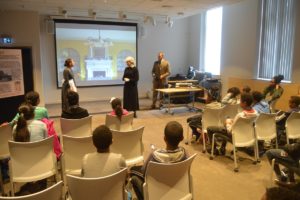
As well as interacting with one another, over the course of the performance each character talked to the audience about how they felt about electricity. Mrs Merton the housekeeper remembered when the electricity was originally installed in the house back in 1901 (powered by a hydroelectric turbine), and had seen a lot of things change and improve over time – whilst acknowledging that new electrical conveniences don’t often work very reliably at first! Betty the maid was nervous of electricity. Her mother was a maid many years ago, when electricity was newer and more experimental, and she passed her anxiety about electrical accidents on to her daughter, even though things were safer by the 1930s. Finally Mr Symes the electrician – a character taken straight from the archival sources – was disappointed at how electrical engineers such as himself were still struggling as a profession to build a reputation, and needed to prove they knew best.
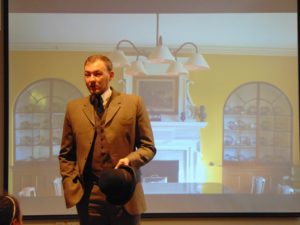
After the performance, the students had the opportunity to ask the characters questions – which they took advantage of in ways we didn’t necessarily expect! We had some great engagement, with questions ranging from ‘how do you make electricity from water?’ and ‘who discovered electricity?’ to ‘is that a wig’ (to poor old Mrs Merton!) and ‘why do you do history?’ – a question which I was very happy to answer myself.
Next we moved on to some museum object handling. Using artefacts from the collections of the University’s Museum of the History of Science, Technology and Medicine, I talked about the history of electricity supply and use in the home. These artefacts included two examples of early batteries – one wet cell one dry cell – with which I pointed out for example that country houses such as Harewood needed to supply their own electricity for a long time before they were connected to centralised power stations, and their electrical installations always included lots of large wet cell batteries. We also touched on the importance of measuring how much electricity you were using, and, in contrast to Betty the maid’s fear of being hurt by electricity, how some people used mild electrical currents as a form of therapy. This last point I illustrated using a particularly interesting object from our collection: an electrical therapy machine designed for use at home, with two electrodes which the user would apply to parts of their body in order to administer a gentle electrical current. This, it was argued, was efficacious against many ills, such as headaches, nervous disorders, and even deafness and baldness. We believe ours dates from the late nineteenth-century, but devices such as these were certainly in use up until the 1920s and 30s.
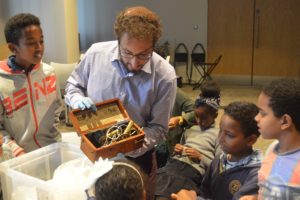
Whilst presenting these artefacts, I talked to students about best practice in museum object handling: the importance of gloves, of using both hands to pick things up and holding them over tables. Next we gave the students the chance to handle some historic objects themselves. Although our own collections were too fragile to allow this, we hired out handling objects from Artemis, the object loans service run by Leeds Museums and Galleries. These domestic electrical appliances from the 19230s, 40s and 50s included hairdryers, a kettle, a wireless set, an iron, a toaster, a vacuum cleaner and a radiator, and students were very keen to put their gloves on and investigate. As a hands-on activity this was very popular; the children were happy to have the opportunity to explore these objects themselves. Knowing they were free to pick them up on their own was invaluable and a great experience.
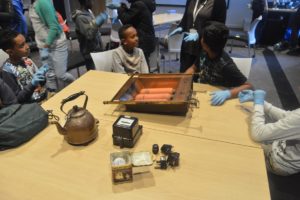
The third and final section of the workshop linked our historical materials to the work the students had done with drama and artificial intelligence. We encouraged them, with the help of our actors, to devise their own short performances about how they thought artificial intelligence might change the way we live in the future. The initial performance was thus a template for them to apply to a new technology: back in the 1930s electricity was beginning to change the way people lived at home through the increasing availability and growing affordability of new electrical appliances. In the future, we asked them, how will people respond if we start using intelligent machines in the domestic sphere? The results were excellent – in small groups the students came up with stories such as: teaching robots how to dance, and thus understanding that they could be fun companions; patients’ concerns about being treated by a robot doctor instead of a human after an accident; a robot teacher who wanted to take over from its human counterpart because it believed itself better suited to the task; and a robot dog which learned by itself how to speak to its unsuspecting owner, but subsequently began to exhibit increasingly subversive behaviour as its intelligence learned and grew, prompting the cliff-hanger question: was it good or evil?
The energy levels in the room were fantastic throughout; the students certainly seemed to have a lot of fun, and we really enjoyed having them!